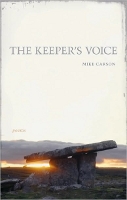 The epigraph of Mike Carson’s new collection serves as a perfect key to his complex, encoded poems. Quoting a translation of Antonio Machado, The Keeper’s Voice begins with an insistence that “the past is not only incomplete /… but is capable of being completed.” The poems that follow test this argument; at the same time, they exemplify it. At their best, Carson’s poems deftly mirror the emotional process of unfolding personal memories with the mental process of reading poetry. What is created in doing so is a constant tension between the promise of an objective truth and the response of the reader’s interpretations.
The epigraph of Mike Carson’s new collection serves as a perfect key to his complex, encoded poems. Quoting a translation of Antonio Machado, The Keeper’s Voice begins with an insistence that “the past is not only incomplete /… but is capable of being completed.” The poems that follow test this argument; at the same time, they exemplify it. At their best, Carson’s poems deftly mirror the emotional process of unfolding personal memories with the mental process of reading poetry. What is created in doing so is a constant tension between the promise of an objective truth and the response of the reader’s interpretations.
This tension allows poems like “Once His Hand” to create a conflict between images of violence and paternal protection—like Roethke’s “My Papa’s Waltz,” on its surface—and then to refuse to resolve either. Instead the poem reveals something new as the abuser tends to the abused speaker’s illness and the poem finds “that fist” and “my body” have both now gone slack in this unfamiliar situation.
These vibrant juxtapositions provide the energy for much of Carson’s work. “Serving Early Mass in Winter” opens the collection by stacking Latin prayer, Catholic tradition, community, self-doubt, and the mechanics of opening a locked gate in winter. The speaker sets fire to a wad of ecumenical pamphlets and then either loses control of the flame or of his imagination:
Whole sheets of fire cut loose across the snow
Catch empty bike racks, float through frozen chains
Of playground swings, then vanish on a hope,
Brief vision, into the darkened playing field,
One beats the fence, snuffs out. I’m down to scraps,
The fire tongues shrink back. The prayers inside
Run down, and black print sinks in the trembling ashflakes.
Once this enormous blaze, this “prayer of fire,” dissipates, it leaves no majesty for the exiting Catholics to witness; the speaker has, he realized, also missed their Eucharist. For both, the cold is taking over and the message has burned away. Poems like “Serving Early Mass in Winter” are presented as though they are undergoing a constant act of self-translation, where clarity comes in stages as the perspective is manipulated. This poem at first seems destined to create empathy either for the accidental arsonist excluded from the church or for the warm community huddled within but, in slow steps, instead reveals how they are alike.
Carson’s poems often begin with cryptic lines that, in fact, serve as a key to the rest of the poem. Carson creates energy out of the internal conflict of lines like “It took two weeks to turn words to fists” and that tension never releases. It builds pressure behind the metaphors until glints of clarity shine through. That line, from “New Kid, St. James School,” opens the poem with a threat of violence which pays off by first frothing into “slobbering” dogs and connecting left hooks. Then the adrenaline burns out of the narrative, leaving the reader with a sense of regret and disgust. What the speaker learns, and shares, is more of the history of violence, and its repercussions, than he signed up for. Likewise, the bullet in “No Surer Heaven” penetrates the target’s heart and burrows through the flesh, as was intended, and then flies on for fifty more years, its worth and damage revealed only in time.
Many of the poems in the first two of Keeper’s Voice’s four sections begin with these knots of cryptic language, emotion, and metaphor. “Fullback” begins with “The second poetry was locker room,” and it takes the full poem to complete the connections first drawn in that line. Carson does not repeat his methods for how to unpack and solve the mysteries his poems lead with. Often they spin off at odd angles from where they started; “Fullback” melds the languages of football and last rites into both an elegy for the dead and paean to those who persevere. Carson’ s work recalls Robert Lowell in this; his poems offer images or concepts observed at first from severe perspectives which are then shifted to show new angles, and to fit both the speaker and the reader into the frame, complicit with what they witness.
As a book, The Keeper’s Voice emphasizes these changing perspectives by maturing the observational voice in the latter sections of the collection. As individual poems allow the reader to “complete” them, the insight of later poems complete the earlier. In “The Deal,” Carson makes explicit the connection between human tragedy and poetry which has reappeared in several of the previous poems. “A word can heal, a word can slit a throat. / My uncle came home once cut ear to ear. / He’d quarreled with a stranger whose razor spoke.” The speaker of the poem is interested not so much in this shocking moment itself but in how people remember moments of confusion. In snapshots, he focuses on how young his mother was, how his uncle’s eyes “blinked…blind,” and how “[w] e’re made of memory,” as though each of these concepts are equal in import to the reader. Then this poem states that it is all equal, that “[w]hatever happens happens to us all,” which may be the clearest description of the way Carson’s poetry works. Whether the poem is dealing in personal revelation, specific detail, or broader thematic statement, the work to connect it all and internalize it is the same for Carson’s speakers as it is for the reader.
In “Indigo Bunting,” this metapoetic tension again connects innocence and experience by balancing the terrible fog of a loved one’s slow death with the specific mysteries of death in nature. They are blended until they overlap; almost in passing, the poem pauses to reflect how “each day as she grows yet more still / We watch with her, uncertain what to say” before racing up-hill to play with the corpse of a snake. In each of these mirrored moments, the permanence of death is misunderstood and very present. The young boy of the poem seems to be running up and down these hills, from corpse to corpse, as if looking for something; the older man whose memories control this poem is holding these two facets of death together as though he will reveal some truth in that overlap. The line “I stop… and hope its compass is set / the way I aim it through a rusty fence” may well be speaking about the role of memory in this collection.
Some of The Keeper’s Voice, however, is less interested in the process of discovering truth. These stand out by feeling complete and having none of the tension his stronger work shows. “The Greatest Generation” has none of the juxtapositional energy found elsewhere, instead operating in simply stated sentiments. “St. Matthew and the Angel,” the longest poem here, eschews the affecting emotional confusion and sharp imagery found in poems like “County Clare” or “Black Autumn” for something more ecclesiastical and imprecise. It is telling, that there is something so distancing about his more clearly stated, personal poems; they don’t need the reader to complete them. However, Carson’s awareness of the reader’s process is powerful, and that sense of inclusion lingers as the work done to comprehend these poems internalizes them and makes them personal.

Anthony Rintala, poet and master eclectrician, spent many years on the hard streets of the American South. He did not live there, he just spent his youth walking down them toward the library or any of a series of comic book spinner racks. The streets weren't all that hard, after all; the asphalt went gooey after the sun shocked and cracked the surface like a crème brûlée. Rintala walked alongside these gooey streets of the American South, reading something, complaining, and thinking about snazzy desserts. That’s how he became a poet.